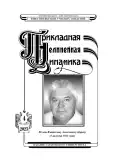Calculation of the cyclic characteristics of the electroencephalogram for investigation of the electrical activity of the brain
- 作者: Aristov V.V.1, Kubryak O.V.2,3,4,5,6, Stepanyan I.V.7
-
隶属关系:
- Федеральный исследовательский центр «Информатика и управление» РАН
- National Research University "
- Moscow Power Engineering Institute"
- Federal State Budgetary Scientific Institution "
- Research Institute of Normal Physiology named after P.K. Anokhin"
- Blagonravov Mechanical Engineering Research Institute of RAS
- 期: 卷 31, 编号 4 (2023)
- 页面: 469-483
- 栏目: Articles
- URL: https://journals.rcsi.science/0869-6632/article/view/250977
- DOI: https://doi.org/10.18500/0869-6632-003051
- EDN: https://elibrary.ru/ZTBPSQ
- ID: 250977
如何引用文章
全文:
详细
作者简介
Vladimir Aristov
Федеральный исследовательский центр «Информатика и управление» РАНРоссия, 119333, г. Москва, ул. Вавилова, 44/2
Oleg Kubryak
National Research University "Moscow Power Engineering Institute"; Federal State Budgetary Scientific Institution "Research Institute of Normal Physiology named after P.K. Anokhin"
ORCID iD: 0000-0001-7296-5280
SPIN 代码: 4789-2893
Scopus 作者 ID: 14042079400
Researcher ID: D-1303-2013
Krasnokazarmennaya 14, Moscow, 111250 Russia.
Ivan Stepanyan
Blagonravov Mechanical Engineering Research Institute of RAS
ORCID iD: 0000-0003-3176-5279
SPIN 代码: 5644-6735
4, M. Kharitonyevskiy Pereulok, 101990 Moscow, the Russian Federation
参考
- Freeman W. J. W.G. Walter: The living brain // In: Palm G., Aertsen A. (eds) Brain Theory. Berlin, Heidelberg: Springer, 1986. P. 237–238. doi: 10.1007/978-3-642-70911-1_17.
- Fontanillo Lopez C. A., Li G., Zhang D. Beyond technologies of electroencephalography-based brain-computer interfaces: A systematic review from commercial and ethical aspects // Front. Neurosci. 2020. Vol. 14. P. 611130. doi: 10.3389/fnins.2020.611130.
- Craik A., He Y., Contreras-Vidal J. L. Deep learning for electroencephalogram (EEG) classification tasks: a review // J. Neural Eng. 2019. Vol. 16, no. 3. P. 031001. doi: 10.1088/1741-2552/ab0ab5.
- Douibi K., Le Bars S., Lemontey A., Nag L., Balp R., Breda G. Toward EEG-based BCI applications for industry 4.0: Challenges and possible applications // Front. Hum. Neurosci. 2021. Vol. 15. P. 705064. doi: 10.3389/fnhum.2021.705064.
- Alimardani M., Hiraki K. Passive brain-computer interfaces for enhanced human-robot interaction // Front. Robot. AI. 2020. Vol. 7. P. 125. doi: 10.3389/frobt.2020.00125.
- Batista A. Brain-computer interfaces for basic neuroscience // Handbook of Clinical Neurology. 2020. Vol. 168. P. 233–247. doi: 10.1016/B978-0-444-63934-9.00017-2.
- Lotte F., Bougrain L., Cichocki A., Clerc M., Congedo M., Rakotomamonjy A., Yger F. A review of classification algorithms for EEG-based brain–computer interfaces: a 10 year update // J. Neural Eng. 2018. Vol. 15, no. 3. P. 031005. doi: 10.1088/1741-2552/aab2f2.
- Schwilden H. Concepts of EEG processing: from power spectrum to bispectrum, fractals, entropies and all that // Best Practice & Research Clinical Anaesthesiology. 2006. Vol. 20, no. 1. P. 31–48. doi: 10.1016/j.bpa.2005.09.001.
- Анохин К. В. Когнитом: в поисках фундаментальной нейронаучной теории сознания // Журнал высшей нервной деятельности им. И.П. Павлова. 2021. T. 71, № 1. С. 39–71. doi: 10.31857/S0044467721010032.
- Побаченко С. В., Колесник А. Г., Бородин А. С., Калюжин В. В. Сопряженность параметров энцефалограммы мозга человека и электромагнитных полей шумановского резонатора по данным мониторинговых исследований // Биофизика. 2006. Т. 51, № 3. С. 534–538.
- Saroka K. S., Vares D. E., Persinger M. A. Similar spectral power densities within the Schumann resonance and a large population of quantitative electroencephalographic profiles: Supportive evidence for Koenig and Pobachenko // PLoS ONE. 2016. Vol. 11, no. 1. P. e0146595. doi: 10.1371/journal.pone.0146595.
- Ma Y., Shi W., Peng C.-K., Yang A. C. Nonlinear dynamical analysis of sleep electroencephalography using fractal and entropy approaches // Sleep Medicine Reviews. 2018. Vol. 37. P. 85–93. doi: 10.1016/j.smrv.2017.01.003.
- Lutz A., Lachaux J.-P., Martinerie J., Varela F. J. Guiding the study of brain dynamics by using first-person data: Synchrony patterns correlate with ongoing conscious states during a simple visual task // Proc. Natl. Acad. Sci. U. S. A. 2002. Vol. 99, no. 3. P. 1586–1591. doi: 10.1073/pnas.032658199.
- Kubryak O. The Anticipating heart // In: Nadin M. (eds) Anticipation and Medicine. Cham: Springer, 2017. P. 49–65. doi: 10.1007/978-3-319-45142-8_4.
- Adelhofer N., Schreiter M. L., Beste C. Cardiac cycle gated cognitive-emotional control in superior frontal cortices // NeuroImage. 2020. Vol. 222. P. 117275. doi: 10.1016/j.neuroimage.2020.117275.
- Heck D. H., Kozma R., Kay L. M. The rhythm of memory: how breathing shapes memory function // J. Neurophysiol. 2019. Vol. 122, no. 2. P. 563–571. doi: 10.1152/jn.00200.2019.
- Aristov V., Stepanyan I. Hypothesis of cyclic structures of pre- and consciousness as a transition in neuron-like graphs to a special type of symmetry // Symmetry. 2022. Vol. 14, no. 3. P. 505. doi: 10.3390/sym14030505.
- Stepanyan I. V., Mekler A. A. Chaotic algorithms of analysis of cardiovascular systems and artificial intelligence // In: Hu Z., Petoukhov S., He M. (eds) Advances in Artificial Systems for Medicine and Education III. AIMEE 2019. Vol. 1126 of Advances in Intelligent Systems and Computing. Cham: Springer, 2020. P. 231–240. doi: 10.1007/978-3-030-39162-1_21.
- Stepanyan I. V., Lednev M. Y., Aristov V. V. Genetic interpretation of neurosemantics and kinetic approach for studying complex nets: Theory and experiments // In: Hu Z., Petoukhov S., He M. (eds) Advances in Artificial Systems for Medicine and Education IV. AIMEE 2020. Vol. 1315 of Advances in Intelligent Systems and Computing. Cham: Springer, 2020. P. 13–28. doi: 10.1007/978-3-030-67133-4_2.
- Iakovidou N. D. Graph theory at the service of electroencephalograms // Brain Connect. 2017. Vol. 7, no. 3. P. 137–151. doi: 10.1089/brain.2016.0426.
- Sporns O. Graph theory methods: applications in brain networks // Dialogues in Clinical Neuroscience. 2018. Vol. 20, no. 2. P. 111–121. doi: 10.31887/DCNS.2018.20.2/osporns.
补充文件









